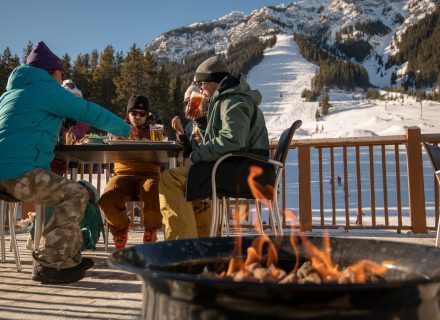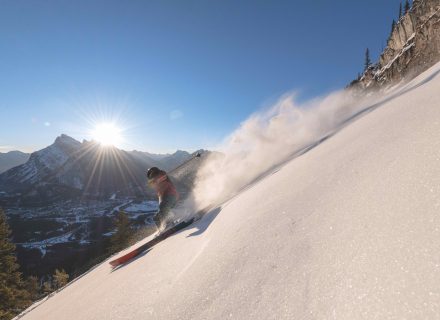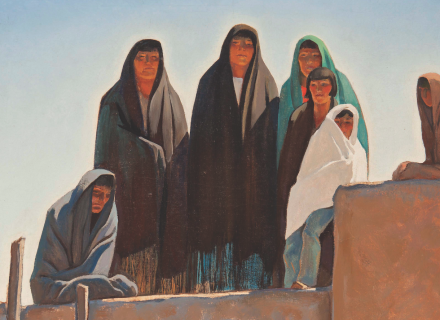At Montana’s historic Flathead Lake Lodge, you can celebrate 75 years of wilderness and freshwater wonder — solo and unchaperoned, if you choose.
In 1934, a 14-year-old Eagle Scout named Les Averill headed into the backcountry near the tiny Montana town of Somers on the north shore of Flathead Lake for a 30-mile wilderness adventure — alone. He carried no food, just a few provisions including a .22 pistol, fishing line, rope, blanket, frying pan, flint, and steel.
Over the course of a week, he crossed the Swan Range, feeding himself by catching trout and killing grouse with a slingshot and stones. Wary of bear, he fashioned beds high in trees, tying himself to branches so that he wouldn’t fall out while he slept.
It’s the kind of story that’s hard to imagine in our digitally managed times, one that required the kind of parental “neglect” that’d nowadays inspire anonymous calls to Family Services.
“The third day I saw more game than any other time during the trip,” he later recounted in To Build a Dream: The Story of Montana’s Les Averill and Flathead Lake Lodge by Rick and Susie Graetz. “I watched a black bear catch fish from a bank along the river and saw a herd of elk on a mountainside. Further up the trail a coyote ran in front of me. Later that afternoon a big buck deer watched me as I was hiking. And that evening I observed mountain goats at play on a ledge.”
Averill arrived at his pickup location at Swan Lake a day early.
“My parents were really happy to see me the next day,” he recalled. “I believe they thought they might never see me again.”
Young Les had always been resourceful, independent, and self-sufficient. In his teens, he became a factory-trained Evinrude engine mechanic, opened a successful boat repair shop with a partner, and learned to fly airplanes. In World War II, he ascended to the rank of major, piloting B-17s, B-24s, and other aircraft in Africa, Europe, and Asia, including treacherous flights over “the Hump” in the Himalayas.
When he returned home after the war — “I had flown 5,000 hours all over the world [and] in all these travels I had never seen an area with as much to offer as the Flathead,” he later said — Averill took out a loan and paid $35,000 for a derelict boys camp on the shores of Flathead Lake. Built in the 1930s, the property fronting 2,000 feet of shoreline with two grand lodges fashioned from locally logged tamarack pine had sat vacant during the war.
Averill wanted to build a place where families could come experience the Montana wilderness he’d grown up with. In its first season after being founded in 1945, the remote Flathead Lake Lodge received few visitors. But as a man and military veteran, Averill was imbued with even more of the confidence that characterized the kid who’d wandered into the mountains with minimal gear and no food.
Today, Averill’s Flathead Lake Lodge is one of the West’s landmark guest ranches. Continually operated by the Averill family — Les’ son Doug and grandson Chase run the place these days — it now occupies an expanded swath of wilderness southwest of Glacier National Park. Families from across the country converge each year on the historic lodge buildings and modern private cabins and conference facilities. Many are repeat visitors, including one guest said to have visited for 56 consecutive summers before passing away.
The emphasis is on outdoor sports that keep everyone active, engaged, and away from their phones. After a while, no one even notices the absence of TVs and other screens at the lodge (though Wi-Fi is available).
At Flathead Lake Lodge, it’s possible within a single day to shoot sporting clays on a private range, mountain bike on a newly built single-track trail, sail on a magnificently restored 1928-built 51-foot racing sloop, and take part in an evening trail ride and steak fry at a secluded camp in the mountains. I know because I did all that on a sunny August day last summer. Other on-site or nearby activities include paddling (canoes, kayaks, paddleboards), swimming (lake and heated pool), hiking, fishing, yoga, tennis, white-water rafting, laser tag, golf, and, of course, touring Glacier National Park.
True to the spirit of its founder, the emphasis is on independence. At Flathead Lake Lodge, that’s not superficial sloganeering. Everything is set up for maximum freedom and minimum hassle.
“One thing that makes our operation a little different is that we give everyone a lot more independence to do whatever they want,” owner Doug Averill says. “Other properties might have some strong ‘I’m the boss, what I say goes’ person running the place. That’s not our style at all. People can walk out the doors of their cabins and take out our sailboats or bikes or any equipment as they please, no questions asked, no forms to fill out.”
That unexpected sense of free-range agency can be disorienting at first for guests who typically come in summer months for weeklong stays, particularly for kids and parents accustomed to schedules, coaches, and appointments. They adjust quickly.
“You see it every time,” Averill says. “The first night the parents stay close to the kids, always keep ’em in sight. By the end of the week they don’t even know where they are. The kids have made friends and gotten to know the area, and they’re just running all over the place.”
With 2,000 private acres and eyes monitoring the lakeshore at all times, there’s plenty of safe yet wild running to do. This is confirmed by a middle-aged guy from San Diego during a spectacular mountain bike ride on the lodge’s property.
“I thought this was going to be a family vacation, but I’ve hardly seen my kids,” he says during a water break. “Which is great! They’re running around somewhere the whole time.”
Longtime lodge staff still recall the story of a family from California who came every year back in the 1970s. Upon arrival, Dad would open the car door and say, “OK, everyone meet back here in a week.” Little has changed.
The afternoon of my mountain bike excursion — a tough uphill start followed by an exhilarating downhill through a fragrant alpine evergreen forest — I fall into conversation with a woman named Shelah from Virginia. We nurse drinks on rocking chairs while taking in views of the deep blue lake. Near the shore, kayaks, canoes, and paddleboards mill about. Out in the deeper water, kids are having a blast climbing the ladder on a raised diving platform and diving in.
Shelah came to the lodge with her grown son and daughter and their kids. They’re all first-timers. “My daughter has been a dedicated rider all her life and my 10-year-old granddaughter is just like her, so they’ve been out riding every day, every chance they get,” she says. “My son and his boys aren’t interested in riding. They’ll get on a horse before the week is out, but they’ve been out swimming and on bikes and white-water rafting and all that.”
So what’s been keeping Shelah busy?
“On trips like this, a grandmother’s job is to not get into any trouble,” she says. “I’m content to enjoy the scenery and hear about their days at dinner. But I grew up sailing, and tomorrow I’m going sailing. That’ll be a treat.”
That evening, a pair of local cowboy musicians entertain a small group around a campfire on the lakeshore. When I squeeze in, they’re in the middle of a saddle-sore version of Jimmy Buffett’s sick-of-the-city ballad “Come Monday.” When it’s over, one of the pair looks at the near-full moon over his shoulder.
“My uncle used to say, ‘Look at that beautiful moon — it’s too bad we’re all married,’ ” he cracks, getting a decent laugh. “I never knew what he meant by that, but it sounded wise.”
A group of kids are the last to drift away from the embers once the show is over.
“Kids don’t grow up with all the cowboy mythology these days, the Roy Rogers and Gene Autry stuff,” Averill says. “But something about the cowboy culture is ingrained. They come out here and they get right into it. They just love it, all the horses and the lodge and cookouts and campfires.”
For all the recreational activities, it’s the horses, ranch hands, and cowboy culture that remain the heart of the lodge, which is also a working ranch. The stable houses 100 to 120 horses at any given time. Morning, afternoon, and evening rides are the hub around which daily activity revolves.
“I don’t know how many thousands of kids I’ve put on their first horse,” Averill says.
At the center of the stable is Liz Cohee, the ranch’s livestock manager. Originally from North Carolina, she grew up training and showing horses in a variety of equine disciplines. Now in her ninth season at Flathead Lake Lodge, Cohee is quickly identifiable for her sure hands and stylish Western wardrobe. She picks up a lot of it from Murdoch’s Ranch & Home Supply, which I know only because after a week of saying things like “Cool shirt!” I had to ask.
Cohee leads me on a three-hour ride through the lodge’s private elk reserve. My mount is Joe, a handsome 10-year-old buckskin quarter horse with a quick pace. Cohee — who spends the off-season traveling the country buying horses for the lodge — picked him up a few years ago shortly after his stint on a Kansas feedlot. Joe is a good-natured type who likely was treated as a tool rather than a pet in his past life. His assortment of scars and scuffs have earned him the sobriquet “Barfight Joe.”
“Once his sores were healed and I was able to start riding him, I quickly realized that Joe was a bit fancier than the typical ‘dude horse’ we have here at the ranch,” Cohee tells me. “He’s got a great handle on him, and lots of cow sense. He’s a real ‘cowboy’s horse,’ and for that reason he is a favorite among the wranglers here.”
Though he’s a little more horse than I’m used to handling, Joe allows me some rookie leeway as Cohee and I make our way through changing foliage, which is already starting to show reds and yellows in August. The fall rut is coming, and when we hit the top of a ridge, we find ourselves 30 or 40 yards from a group of five elk. The horses and elk are accustomed to each other, allowing us a memorable horseback view of a large bull to our left and the expansive spread of Flathead Lake below to our right.
It feels almost primordial coming face to face with that ancient species in view of what I’ve learned is the watery remnant of an ancient glacial dammed lake.
The only feature of the resort that trumps the top-notch stable is the continental United States’ largest freshwater lake west of the Mississippi. Flathead Lake runs 27.3 miles north to south with a maximum width of 15.5 miles. With 187.6 miles of shoreline, the massive body of freshwater is a unique feature among resort ranches. Among other benefits, it all but alleviates one of the issues that can be a constant feature of many ranches — no dust and dirt invading lodges and cabins here.
All of that is neither here nor there for the elk, who fix us with slightly apprehensive but surprisingly nonchalant stares before moving off deeper into the woods.
For all of the upgrades and concessions to modernity — including an on-site massage center — it’s the property’s legacy and tie back to Les Averill that ensure Flathead Lake Lodge’s position among the West’s top resorts 75 years after opening. The main lodge looks just as it did when the likes of Bing Crosby, U.S. military legend Commander Matthew Ridgway, and even Las Vegas gangster “Bugsy” Siegel spent time here.
They had drinks in the same small Western bar and admired many of the same trophies, including a seven-point buck, bison, moose, mountain lion, wolverine, and a grizzly that charged Les Averill himself. While cleaning the skull, Les discovered he’d shot the charging bear right in its open mouth. The bear’s skin has hung in the main lodge ever since.
“This place hasn’t really changed since the 1930s and ’40s,” says general manager Chase Averill. “We’ve modernized the infrastructure and added new activities, but what you see in the main lodge is what you would have seen in the 1930s.”
In the main dining room — a 130-foot lodge pole spans the hall — Les loved to enforce his lack-of-pretension rules by shearing off the necktie of any man who showed up for dinner wearing one. The only concession to the place’s popularity among celebrities is allowing select visitors to autograph the bottoms of the wooden seats (the same sturdy ones built in the 1930s) in the dining room. I turn over a few in search of A-listers and find signatures from actor John Lithgow and Toto guitarist Steve Lukather, whose 2011 inscription reads, “This is not Africa, loved it though!”
In a place with the kind of sustained history of excellence as Flathead Lake Lodge, it doesn’t really matter if you’re partial to Bing Crosby, an ’80s pop musician, or the next big thing. No one stands on ceremony here. The fire in the main lodge still crackles throughout the day, and the wilderness outside still calls to independent souls with a song that’s been in the air here since before anyone can remember, and that no one who comes ever forgets.
For more on Flathead Lake Lodge, visit flatheadlakelodge.com.
Photography: Images courtesy Flathead Lake Lodge, Hoah Clayton
From our April 2020 issue.























